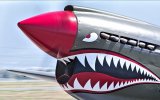Looks like a Harbor Freight wheel from the bright yellow paint? I have an older one from around 12-15 years ago, it's just ok for small panels. I put a dial indicator on the frame and can open it up something like .050-.060" just pushing the top and bottom apart by hand, they definitely need reinforcing. Our cast iron Dake #1 arbor press only flexes a few thousands with all my 170 pounds on the handle in comparison. I haven't measured how much the frame flexes under enough tension to shape 18g steel, but definitely enough to throw off the wheel alignment a bit. The full radius dies kind of make that a non-issue though; the contact patch is always touching the same radius on the lower wheel even if the angle between the top and bottom wheels has changed due to deflection.
The "toe" alignment of mine is way off, like in your video. It's bad enough that I can't make a pass over ~15" without the wheels getting in a bind from tracking at different angles. You'll have to make a way to keep the wheels tracking in the same plane or else they'll bind up and twist the frame, and you won't get consistent results with it. I've never been able to get consistent tracking with mine to make a low crown panel like a door skin.
I'm not sure that mine has helped me learn to use an english wheel all that much since it doesn't really behave like an english wheel should lol. I'm sure with enough modifications and bracing it can be a usable wheel for bigger projects.

